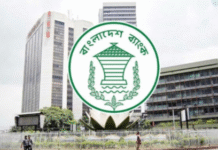A currency turmoil engulfing India has left neighbour Bangladesh untouched, thanks to Dhaka’s relentless pursuit of textile exports, reports the Kolkata-based daily ‘The Telegraph’.
The rupee fell 15 percent in one year and India’s foreign exchange reserves depleted 4 percent, while the Bangladesh currency, taka, rose 5 percent to 77.75 against the dollar in August 2013 from 81.38 in August 2012.
Bangladesh also saw its forex reserves rise 45 percent to $16.21 billion this year from $11.32 billion last August.
The report headlined “Dhaka lesson to beat currency turmoil” said Finance Minister Abul Maal Abdul Muhith was successful in pushing exports, which when added to remittances from Bangladeshis working abroad, paid for the country’s import bill, leaving a current account surplus of $2.5 billion in 2012-2013.
“The country, whose principal export item is garments, sold goods worth some $27 billion to the world, registering an 11.32 percent rise in earnings over the previous year”. Garments account for 80 percent of Bangladesh’s exports.
In contrast, India’s exports during the period, sprawling across textiles, gems and jewellery, engineering goods and pharmaceuticals, were a mammoth $300.68 billion. However, earnings were 1.76 percent lower than the year before.
Cheap labour, low overhead costs and a national commitment to its exports have helped Dhaka to muscle out rivals India and China in the lower, mass-manufactured end of the world-wide garments business, despite drawing the ire of labour and human rights bodies for its poor safety and labour standards.
Bangladesh gives top priority to the garments business — trucks carrying clothes are treated as VIP vehicles and police have orders to clear road-blocks and traffic snarls to ensure they reach the ports on time.
Bankers ensure easy paperwork for transactions, while custom officials do not hassle export consignments. Raw materials are duty free.
At the same time, red tape and poor regulation have increased the cost of business in India, turning sour the growth story in manufacturing, the report said.

Unlike India, which mainly imports energy, gold, electronics and capital goods, Bangladesh imports virtually everything it needs to live — rice, wheat, meat, eggs, machinery, cars and petroleum products. Yet it has managed to contain its import in 2012-13 at the 2010-2011 levels.
India, on the other hand, has done little to raise its exports. The economic reforms have relied on opening up the domestic market to imports to infuse competition and ensure reduced cost and better quality of domestic manufactures.
A string of free trade pacts have been signed starting with Asean to the latest with Japan. However, the pacts have seen imports from these economic powerhouses rising at a faster pace than exports.
India’s overall exports rose to $300 billion in 2012-13 from $18.5 billion in 1990-91, while imports rose to $498 billion in 2012-2013 from $24 billion in 1990-1991.
“Told in a different way, India’s exports rose in these 22 years some 15-fold, while its imports rose 20-fold, widening the trade gap and the current account deficit, fuelling the fall of the rupee”.
Source: Bd news24









